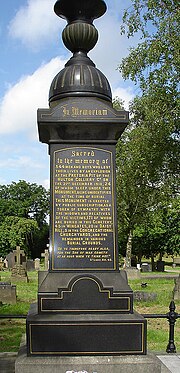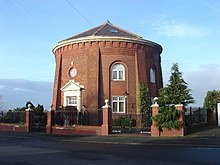Westhoughton
[2] Within the boundaries of the historic county of Lancashire, Westhoughton was once a centre for coal mining, cotton-spinning and textile manufacture.
[3][4] Westhoughton incorporates several former villages and hamlets which have their own distinctive character, sports traditions and amenities, including Wingates, White Horse, Over Hulton, Four Gates, Chequerbent, Hunger Hill, Snydale, Hart Common, Marsh Brook, Daisy Hill and Dobb Brow.
[6][7] The people of Westhoughton are sometimes known as "Howfeners" (from Houghton) or "Keaw-yeds" (cow heads) or "Keawyedners" (a combination of the two), and the town is known as "Keawyed City".
[10] On 15 December 1642, during the English Civil War, the Battle of Warcock Hill was fought on Westhoughton Common between Lord Derby's Cavalier forces and Parliamentarians.
It is believed that Prince Rupert of the Rhine gathered his troops in Westhoughton before the attack and ensuing massacre at Bolton in 1644.
[citation needed] On 25 March 1812, a group of Luddites burned Rowe and Dunscough's Westhoughton Mill.
[11][12] James Smith, Thomas Kerfoot, John (or Job) Fletcher and Abraham Charlston, were sentenced to death for their part in the attack.
[15] The riots are commemorated by a blue plaque on the White Lion public house opposite the mill site.
[21] Lying within the boundaries of Lancashire since the early 12th-century, Westhoughton was a chapelry and township in the ecclesiastical parish of Deane, in the Salford hundred.
[23] Westhoughton Town Hall was built in 1903 to a plan by Bradshaw and Gass, architects of Bolton replacing the Local Board Offices at the junction of Market Street and Wigan Road.
[24] Under the Local Government Act 1972, Westhoughton Urban District was abolished in 1974 and its area became a civil parish of the newly created Metropolitan Borough of Bolton in Greater Manchester.
[6] The town incorporates several former villages and hamlets including railway stations including Wingates, White Horse, Over Hulton, Four Gates (or Fourgates), Chequerbent, Hunger Hill, Snydale, Hart Common, Marsh Brook, Daisy Hill and Dobb Brow.
[5] Local Nature Reserves are located at Hall Lee Bank Park, Cunningham Clough, and Eatock Lodge at Daisy Hill.
[37][38] A new church, designed by architects Dane, Ashworth & Cottam, was built at a cost of about £1 million,[39] and consecrated in 1995 by the Bishop of Manchester.
[40] Nicholsons of Malvern built its two manual organs with 1,256 pipes, ranging from 1/2 inch to 16 feet (4.9 m) made of tin, spotted metal and hammered lead.
The red brick and terracotta town hall and Carnegie library were built between 1902 and 1904 to the designs of Bradshaw & Gass.
The motorway separated the townships of Hunger Hill and Chew Moor from the rest of Westhoughton and the Bolton Road was completely severed.
Although the route was fully allocated and all planning and public consultation completed, the project was shelved due to financial constraints.
The annual usage of Daisy Hill and Westhoughton stations was more than 500,000 passengers in 2013/14, greater than many major UK towns.
Services 520, 559 and 607 serve Bolton Interchange for further bus and rail connections to areas such as Bury, Preston, Manchester and Chorley.
The weekly Horwich and Westhoughton Journal was published (by The Bolton News) from 1925 until 1980, and had an editorial and revenue office in Market Street.
[55] A small museum has exhibits that relate to the Pretoria Pit Disaster and a large, encased model, of the original St Bartholomew's Parish Church, built from match-sticks.
Television signals are received from the nearby Winter Hill TV transmitter situated north of the town.





